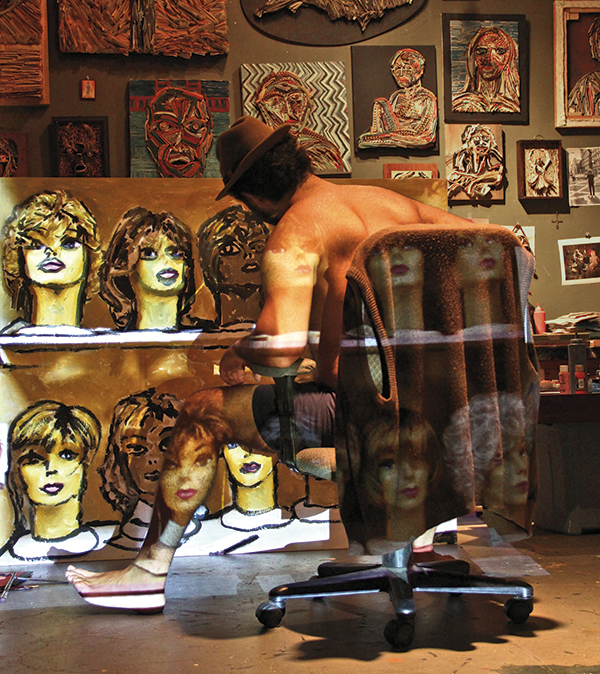Print to Artifact
 Nick Georgiou is a friendly, outgoing Tucson artist whose rapid-fire commentary on his art is punctuated with wide grins. He recycles old books and newspapers to create unique sculptural forms that have a surprisingly dark theme given the sunny nature of the artist.
Nick Georgiou is a friendly, outgoing Tucson artist whose rapid-fire commentary on his art is punctuated with wide grins. He recycles old books and newspapers to create unique sculptural forms that have a surprisingly dark theme given the sunny nature of the artist.
Georgiou’s artwork is “literally a reflection of what is going on around us,” he says, because the sculptures are made from the news of the day. Since the news is often bleak, Georgiou makes clear that, “You have to be courageous to be an artist because art is very revealing. Modern art is a mirror to what is happening now in the world.”
“My work is print-to-artifact. I want to give new meaning and new life to the printed word.” He sees the contemporary world in a state of “transition and upheaval.” These days he’s working on the upheaval caused by the tangible print world giving way to the digital world – a world which he says has revolutionized everything, even how we interact with each other.
Georgiou views some of his works as “beautiful and delicate” and others as “aggressive.” He laughs and shrugs his shoulders. “Some of the sculptures ask me ‘Why did you bring me into life?’” He points out that the eyes of the faces in his sculptures are not open. “The eyes are fossilized. This makes you turn back and reflect on yourself” when looking at those eyes, he says.
Georgiou is a native of New York City, and a graduate of New York Universities’ Tisch School of the Arts. He has lived in Tucson for four years. He was in New York City only a few blocks from the World Trade Center when it was attacked on September 11, 2001. The events of 9/11 pushed him to make sense of what was happening around him. “The city was full of fear and paranoia then. The conversation was really dark.” Soon after, he began making his sculptures from recycled newspapers. He literally began turning the news about the terrorist attacks into art.
Next Georgiou placed his new three-dimensional animal-form sculptures in front of the New York Times building to photograph them as public art. This attracted the attention of the authorities at a time when everyone was cautioned to, “See Something. Say Something.” Eventually Georgiou was able to convince the police that he was not scouting potential sites for terrorism. Today he puts his sculptures in public places in Tucson. He likes it that in Tucson, people passing by will actually stop and interact with the sculptures.
Georgiou came to Tucson four years ago for a temporary gig as Artist-in-Residence at the University of Arizona. He arrived early to make art from Tucson books and newspapers, and rented a studio space in Citizens Warehouse on 6th Street. He never left. He describes Tucson as “magical,” and a “blessing.” But the moment he knew he had fallen “deeply in love with Tucson” (his words) was when he stood on the roof above his studio, and watched his first All Souls Procession unfold in the streets below. “Amazing, just amazing,” he remembers.
Georgiou thinks that books and papers will continue to exist, but most information will be in digital form. He points out that he can store hundreds of books on his iPad. He grins again. “The story never changes. The vehicle changes.”
Georgiou has shown his work at Davis Dominguez, Etherton Gallery, and Rocket Gallery in Tucson. In October, he will show work at Obsidian Gallery, and in the Tucson Open Studio Tour in November.
Learn more about Nick at http://myhumancomputer.blogspot.com/
Category: Arts




